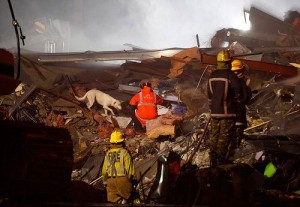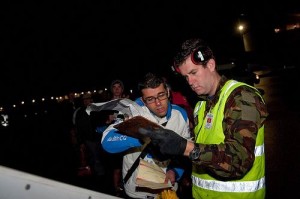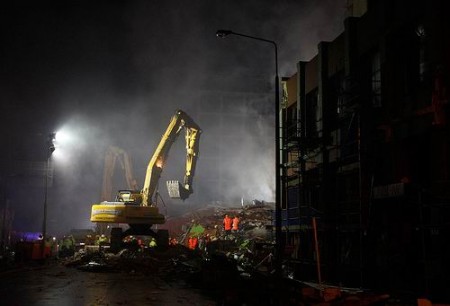In late February, I had my first experience of worrying from afar about a good friend caught in a catastrophic earthquake. The anxiety started just before six in the evening of February 21st, after I’d knocked off work for the day and idly flipped on the radio to catch some news. I was only half paying attention, concentrating instead on how I was going to pull together a meal from the fridge’s sparse contents, when I suddenly heard a live interview with a very distraught woman in Christchurch.
The mere mention of Christchurch and the fear in her voice immediately caught my attention. For weeks, I had watched my tennis coach and good friend Glenn Richard train hard to represent Canada in the world seniors tennis tournament in Christchurch, New Zealand. Our conversation had been about little other than Christchurch–the draw, the players, the logistics of the tournament. Then Glenn had flown off to compete. Where was he now? Was he safe?
I turned up the radio and began pacing. The initial news–a 6.3 earthquake close to the surface, buildings in jagged rubble, people entombed in the debris–sounded terrible. And the more I heard, the more worried I got. I had some dinner with my husband, then went online to see what if anything I could learn. By then, two and a half hours had elapsed since the first devastating tremor.
At that point, something almost miraculous happened, or so it seemed then. While googling, I landed on a screen called the Google Person Finder. Someone at Google had just posted it for the Christchurch earthquake. It looked almost homemade, nothing fancy, just two boxes–a green rectangle that said “I’m looking for someone” and a blue one that said “I have information about someone.” I clicked on the green box and entered Glenn’s name. I didn’t expect much. But to my astonishment, I got an immediate message. Glenn was alive. My sense of relief was enormous. How did Google do it, I wondered?
 In taking a closer look later, I discovered there are actually two different but closely related Googles–the Google we see every day on our screens, google.com, and a second less visible outfit, google.org, dedicated to philanthropic and humanitarian work. And it’s the latter that possesses a crisis response team that rolls out Google’s considerable technological expertise when a major natural disaster strikes.
In taking a closer look later, I discovered there are actually two different but closely related Googles–the Google we see every day on our screens, google.com, and a second less visible outfit, google.org, dedicated to philanthropic and humanitarian work. And it’s the latter that possesses a crisis response team that rolls out Google’s considerable technological expertise when a major natural disaster strikes.
The idea for an online person finder came up soon after the crippling 2010 earthquake that struck Haiti. At the time, major news organizations such as CNN and the New York Times were collecting and posting names of the missing as well as those of the dead and injured. But these sites didn’t share the information back and forth. So if a worried family member entered the name of a missing relative on one site and an aid worker entered news of that same relative on another, there was no exchange of info. Families would have to go from site to site, hoping desperately to connect the dots.
 So Google’s programmers decided to bring all this disparate information together. After consulting with the U.S. State Department, they began creating software that would continually search for data on missing people all over the internet and make them available on one site. Less than 36 hours later the programmers were done, going online with a Person Finder in English, French and Creole.
So Google’s programmers decided to bring all this disparate information together. After consulting with the U.S. State Department, they began creating software that would continually search for data on missing people all over the internet and make them available on one site. Less than 36 hours later the programmers were done, going online with a Person Finder in English, French and Creole.
Thirteen months later, the Google team posted a similar site for the Christchurch earthquake and three days ago they did the same for the catastrophic events in Japan. When I last checked, the Japanese Earthquake Person Finder was tracking 127,300 records of people, a powerful indication of the human need for such information.
Google.org has also obtained satellite imagery taken Saturday, March 12, of the worst-hit areas in Japan and provided these vital images online to emergency response organizations, who now need to find ways to get aid to the afflicted. These pictures are immensely troubling, particularly the pre- and post-earthquake images of the Fukushima II nuclear power plant.
I’ve long been a huge fan of Google because I believe in its mission to organize human knowledge and make it accessible and available to all. And never is this knowledge more important, I think, than when it arrives in our hour of need.
Photos: Upper and Middle Photos were taken in Christchurch on February 25, 2011, courtesy of 第③ª类视觉. These two photos, some of the most haunting that I’ve seen from the disaster, show rescue workers searching for survivors in the rubble. The bottom photo shows evacuees being loaded onto RNZAF aircraft after the Christchurch earthquake, courtesy of Royal New Zealand Navy.

One thought on “Google in Our Hour of Need”
Comments are closed.